Install and Customize a Salesforce Labs Solution
Learning Objectives
After completing this unit, you’ll be able to:
- Install a Labs solution
- Understand how to customize a Labs solution
Discover Labs Solution System Requirements
Lincoln is ready to install a great Salesforce Labs solution into his org.

After the search Lincoln did in the previous unit, he’s convinced that PMT will help his team better manage their projects and programs. He’s excited to install and configure it.
If you’re following along with Lincoln, return to AppExchange, search for Project Management Tool - PMT, and click the PMT listing.
Before Lincoln installs this solution, he double-checks its system requirements. Here are the steps he follows.
- On an AppExchange solution listing, click More Details.
- Review the Compatibility and App Details sections.
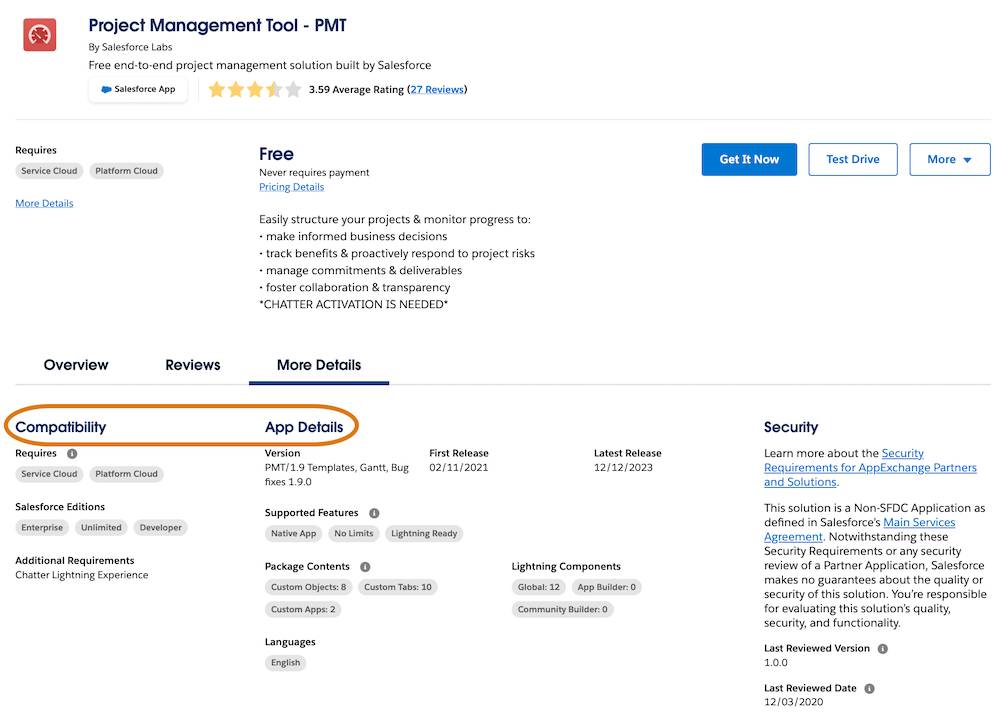
Lincoln quickly sees in Compatibility that PMT requires Service and Platform clouds, and is supported by the editions Ursa Major runs. Great! Lincoln also reviews the app details. Everything looks good.
Install a Salesforce Labs Solution
You'll be completing these hands-on, step-by-step units in your own personal Salesforce environment, called a Trailhead Playground. Get your Trailhead Playground now by first logging in to Trailhead, and then clicking Launch at the bottom of this page. Your playground opens in a new browser tab or window. Keep the playground window open while you follow the step-by-step instructions. After you complete the steps in your playground, come back to this window and click Check Challenge to Earn 500 Points at the bottom of this page.
Now, continue learning along with Lincoln by installing PMT into your org.
- On an AppExchange solution listing, click Get it Now.
- In Where do you want to install this package? Choose your connected Salesforce Account. Click Install in Production. In Confirm Installation Details, check the terms and conditions checkbox.
- Click Confirm and Install.
- When prompted, log in to the Salesforce org where you want to install PMT.
- Click Install.
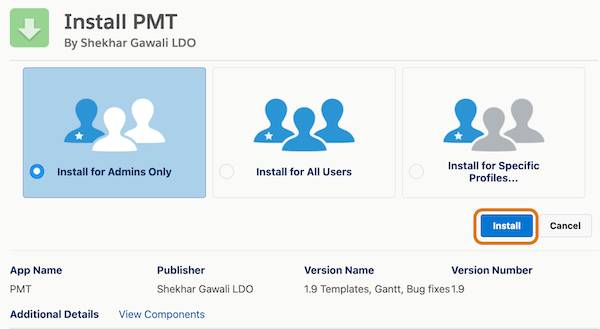
- Click Done.
- Confirm that PMT is in your list of Installed Packages in your org.
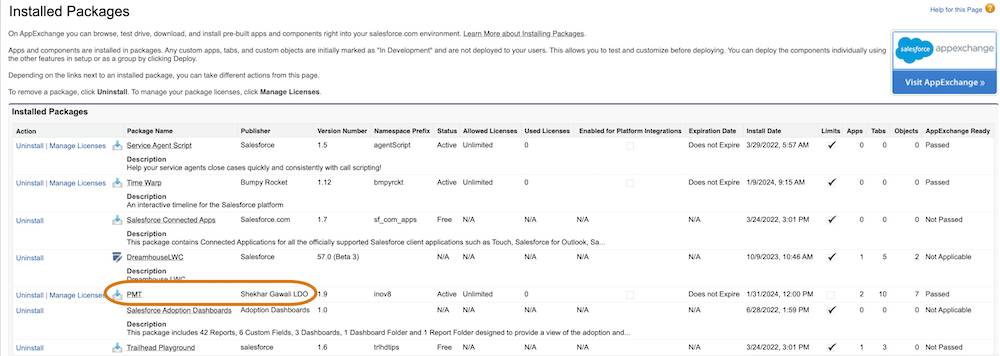
Interact with Your Installed Labs Solution
Now that PMT is properly installed in his org, from its AppExchange listing, Lincoln finds the user guide on the More Details tab and reads it. PMT is a Lightning app, so Lincoln is ready to test this app out in his org.
- In your Salesforce org, click the App Launcher
 .
.
- Type and select PMT.
The PMT app opens. Here, Lincoln and his teammates can get a personalized view of project assignments, tasks, and cases.
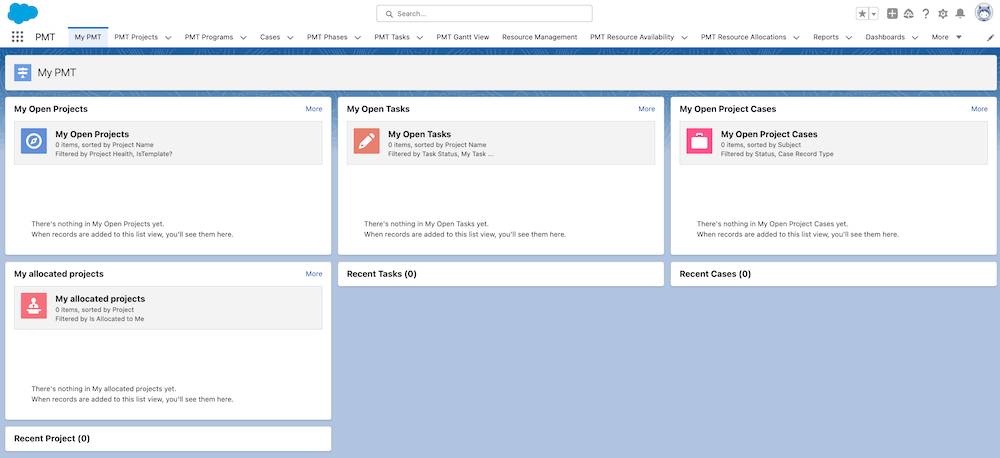
Lincoln explores the app and finds there are many other objects to help manage his team’s portfolio, including:
- My PMT
- PMT Projects
- PMT Programs
- Cases
- PMT Phases
- PMT Tasks
- PMT Gantt View
- Dashboards
- Chatter
- Approval Requests
Great! It looks like PMT has much of what his team must optimize to modernize their program and project management.
Next, Lincoln creates a new project: he finds that the process is straightforward and intuitive.
Create a Project
He follows these steps.
- Click the PMT Projects tab.
- Click New.
- Fill out the following details. You may need to scroll to access all sections. Set the following values:
- Project Health to On Track.
- Project Current Status to Initiate.
- Project Name to Demo Project.
- Project Initiator to IT.
- Portfolio to P2P as the Chosen value.
- Initial Start Date to 2/1/2024.
- End Date to 1/31/2025.
- Level of Effort to Medium.
- Click Save.
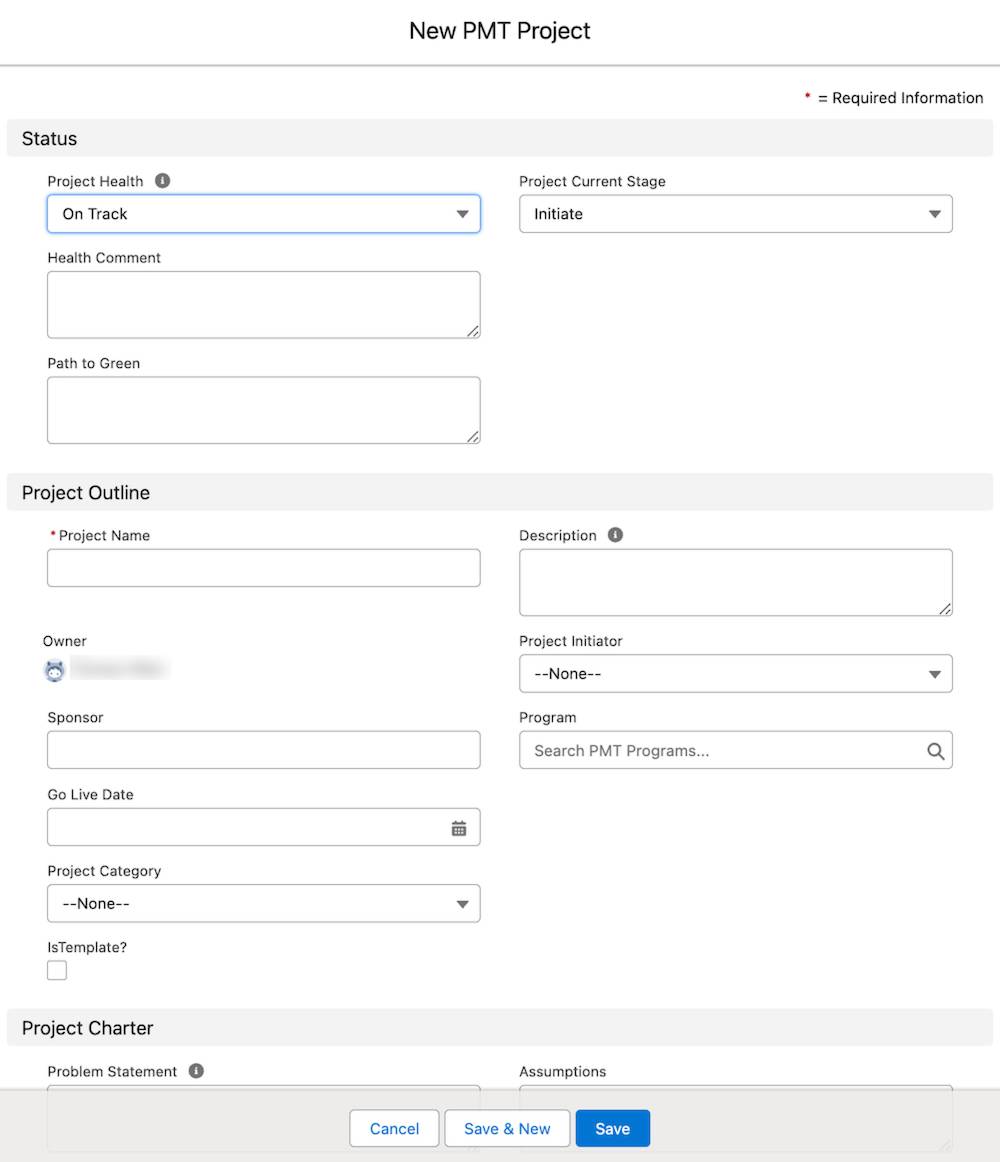
Create Project Phases
Next, Lincoln creates the project phases Ursa Major needs.
- Click Create Phases.
- Create these phases.
|
Phase Name
|
Phase Health
|
|---|---|
Planning |
On Track |
Execution |
Not Started |
Initiation |
Completed |

- Click Submit.
- Click X to close the Create Phases window.
Create Project Tasks
Finally, Lincoln creates tasks and assigns them to phases.
- Click Create Tasks.
- Create these tasks.
|
Phase
|
Task Name
|
Start Date
|
End Date
|
|---|---|---|---|
Planning |
Proposal Evaluation |
Feb 1, 2024 |
Feb 28, 2024 |
Execution |
Conduct Safety Audits |
Mar 1, 2024 |
Mar 31, 2024 |
Initiation |
Procure Assembly Line |
Jan 31, 2024 |

- Click Submit.
- Click X to close the Create Tasks window.
Just like that, Lincoln can see his project tracking coming together.
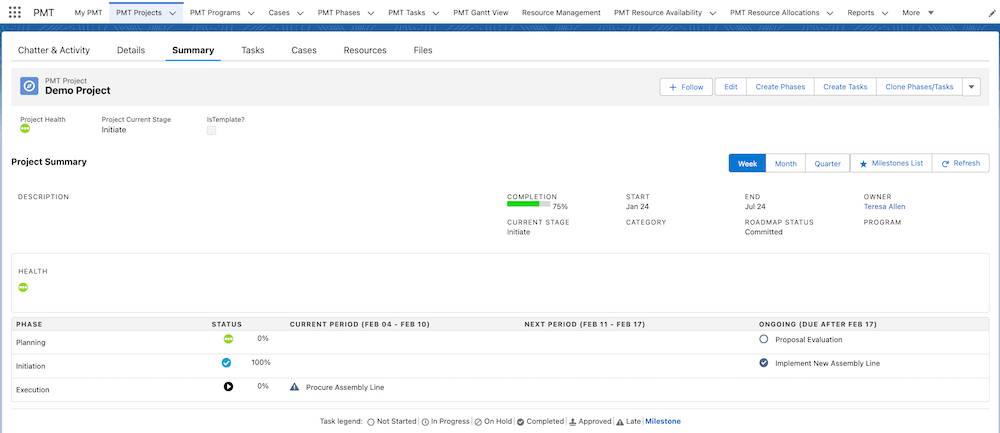
Customize Your Labs Solution
Like many Salesforce Labs solutions, PMT is fully customizable. After it’s installed–or depending on the solution, before–there are many ways that you can customize Salesforce Labs solutions and make them unique to your business needs.
Managed Packages
A managed package is a package that is easily upgradeable, but locked from making changes once installed in an org. Most of the time, managed packages offered through Labs are ready to use out-of-the-box and don’t require any customizations to use.
However, if your organization does want to build new features into the package to meet specific business challenges, or if you want to build something similar from the ground up, the source code for managed packages is often available in the official Salesforce Labs GitHub repository. Pull the code and work your magic in code to create entirely new features.

On the Salesforce Labs GitHub repo, browse all Labs open-sourced solutions.
Remember that each Salesforce Labs solution is different, so when retrieving source code from Github, check out its GitHub readme for specific guidance on how to implement and use the solution.
Some Labs solutions issue automatic managed package version upgrades, but for most Labs solutions, upgrades aren’t automatic.
- When managed package upgrades aren’t automatic, return to the AppExchange listing, and install the solution again–you see the package complete an upgrade rather than a new installation.
- When managed package upgrades are automatic push upgrades, these solutions are managed with additional care, and thorough testing is performed prior to each release.
Unmanaged Packages
The majority of Salesforce Labs solutions are managed packages. However, about 1 in 4 Salesforce Labs packages are unmanaged. Simply put, unmanaged packages enable you to customize a solution directly within your Salesforce org after it’s installed. In your org, access the unmanaged package custom objects, metadata, fields, workflows, and Apex code. Edit the package contents in whatever ways you need directly in the org, without needing to pull source code from GitHub.
Managed Versus Unmanaged Packages
How can you tell if a Salesforce Labs solution is a managed or unmanaged package? Find all the technical details about your Labs solution on its AppExchange listing in its App Details section.
For example, in PMT’s AppExchange solution listing Supported Features section, Lincoln notices that it’s a native app. This means the solution is built on Salesforce for Salesforce. Native apps can be customized to an extent, but are limited in receiving updates.
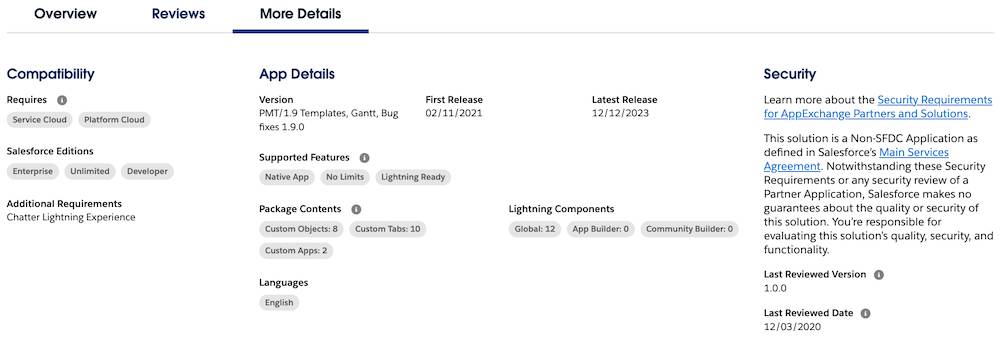
If Lincoln and his team wish to build new features onto this package to meet specific additional business needs, they can pull the source code from GitHub.
Now that Lincoln has installed PMT, he meets with his developer team. They want to access the source code to adjust the component’s behavior.
The most efficient way to find a managed package solution’s GitHub repository is from its AppExchange solution listing More Details tab, Resources & Documentation section.
From PMT’s AppExchange listing, Lincoln clicks the More Details tab. He scrolls to the Resources & Documentation section. He clicks GitHub Repository to open PMT’s repo.From the Salesforce Labs GitHub repo, Lincoln’s developer team downloads the source code.

Since Lincoln’s developers work with teams internally and externally, they configure PMT to assign resources to contact along with users. Lincoln also adds custom objects on top of the app to keep track of budgeting and finances. Talk about an upgrade!
Troubleshoot Your Installed Labs Solution
Lincoln checks out PMT’s resources in case he has questions about the solution down the road. While Labs solutions aren’t officially supported, he can return to its listing to get some guidance.
In AppExchange, Lincoln clicks the PMT listing and returns to the More Details tab.
Lincoln reads the FAQ and learns about common challenges that previous users have experienced. Next, Lincoln pours a cup of coffee and digs into reading PMT’s admin and user guides. So many great resources!
Wrap It Up

Lincoln is pleased! He found a Salesforce Labs solution that enhances the output of his Sales team. He found and installed PMT, and then found a couple more Labs solutions—like AppExchange Dashboard Pack for Sales, Marketing, and Service—that he installs as well.
To continue your journey with AppExchange and Salesforce Labs, keep learning by completing the Meet Your Business Needs with AppExchange Trailhead Trail.
Resources
- AppExchange: Project Management Tool - PMT
- GitHub: SalesforceLabs
- Salesforce Help: How to Get Support for Salesforce Labs Created Applications
- Trailhead: AppExchange Basics
- Trailhead: Meet your Business Needs with AppExchange
